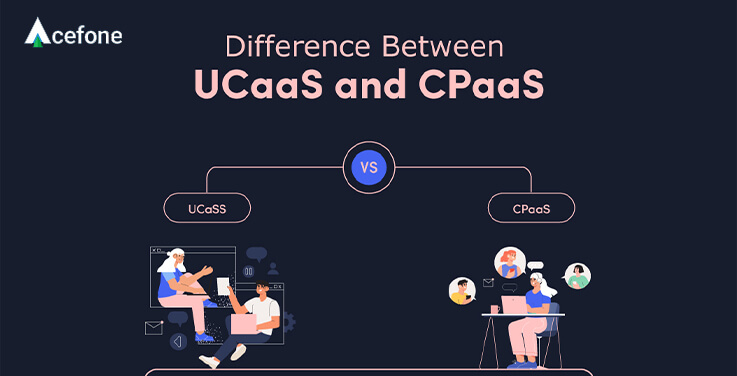Businesses are moving on from on-premise systems to cloud-based communication platforms. Once they ascertain their communication needs, companies can select a service that they think suits their organisational goals and caters well to their target audience.
Unified Communication as a Service (UCaaS) and Communication Platform as a Service (CPaaS) are cloud communication solutions that offer different benefits and services to enterprises of all kinds and sizes.
Unified solutions are an ideal option as they integrate various modes of communication into a single platform to improve customer experience. UCaaS combines team messaging, video conferencing, chat, email, and cloud phone into a single application.
A communication platform is a cloud delivery model that integrates real-time communication (voice and video) into business applications by deploying APIs. Organisations can personalise their communication stack based on their business and security needs.
Acronyms related to cloud-based communication technology often feature “aaS” as a suffix. The term “aaS (as a service)” can be SaaS (Software as a Service), VCaaS (Video Conferencing as a Service), CCaaS (Contact Center as a Service). Businesses can opt for these services based on their requirements.
Let’s learn a little more about UCaaS and CPaaS and how they differ from each other.
UCaaS and CPaaS are both flexible cloud communication systems. UCaaS allows unifying communication applications like voice, video, chat, and email into a single dashboard. On the other hand, CPaaS allows developers to make real-time communication applications without creating any back-end interface.
Difference between UCaaS and CPaaS
UCaaS and CPaaS enable cost-effective and user-friendly business communication. However, there are certain differences between both solutions. Let’s look at a few:
| UCaaS | CPaaS |
|
UCaaS platforms function as pre-configured, comprehensive solutions for your communication needs. You get a predefined suite of features, including voice over internet protocol (VoIP) calling, video conferencing, instant messaging, and integrated collaboration tools. |
CPaaS solutions prioritize developer-centric functionalities. They act as modular building blocks by offering Application Programming Interfaces (APIs) and Software Development Kits (SDKs). With these tools, your developers can integrate communication functionalities seamlessly into existing applications. |
| UCaaS platforms generally offer limited customization. The features and functionalities are predetermined by the provider, and you have access to what is included within their chosen plan. | CPaaS solutions are highly customizable. Your developers have the flexibility to select and integrate only the required communication features. This enables you to tailor communication experience according to your workflows. |
| UCaaS platforms prioritize ease of use. Deployment is typically quick and straightforward, often requiring minimal technical expertise. | Implementing CPaaS requires development expertise. Your developers must thoroughly understand the APIs and SDKs provided by the CPaaS platform and have the necessary skills to integrate them seamlessly into existing applications. |
| UCaaS platforms primarily target everyday business users, including employees from non-technical backgrounds. | CPaaS solutions primarily aim at developers with higher level of technical skills, who are tasked with building custom communication experiences. |
| UCaaS pricing structures are often based on a per-user or per-feature model. | CPaaS pricing models can vary. Some providers charge based on usage (e.g., per call, per message sent), while others might have tiered pricing plans with different feature sets. |
Both UCaaS and CPaaS solutions have their benefits, but the answer to which is better depends on what your business is looking for from your communications.
If you need a more flexible way to communicate with clients and customers and have the technical know-how to build apps to provide innovative ways to communicate with your customers, then a CPaaS would be for you.
If you are looking to boost internal communications and are looking for a simple solution which provides feature-rich telephony at low costs, UCaaS is for you.
Benefits Of UCaas and CPaaS
Both CPaaS and UCaaS have revolutionised the way businesses operate over the cloud. Companies can avoid the stress of managing back-end infrastructure, and focus on growth and building customer relations.
CPaaS and UCaaS offer similar benefits to an enterprise. They are as follows:
- Easy to use: The implementation is straightforward and users can access these solutions as easily as traditional tools.
- Scalable and cheap: You can access both technologies through the cloud, and scale up and down based on your needs. CPaaS adds new features while UCaas removes additional hardware.
- Growth: These solutions include unified communication apps, chatbots and more. These tools are also easy for businesses to leverage.
- Opportunity – In UCaaS, companies can work across a range of networks and devices for businesses.
![Difference Between UCaaS and CPaaS[Infographic] Difference Between UCaaS and CPaaS[Infographic]](https://www.acefone.com/blog/wp-content/uploads/2021/05/difference-between-ucaas-and-cpaas-infographic.jpg)














